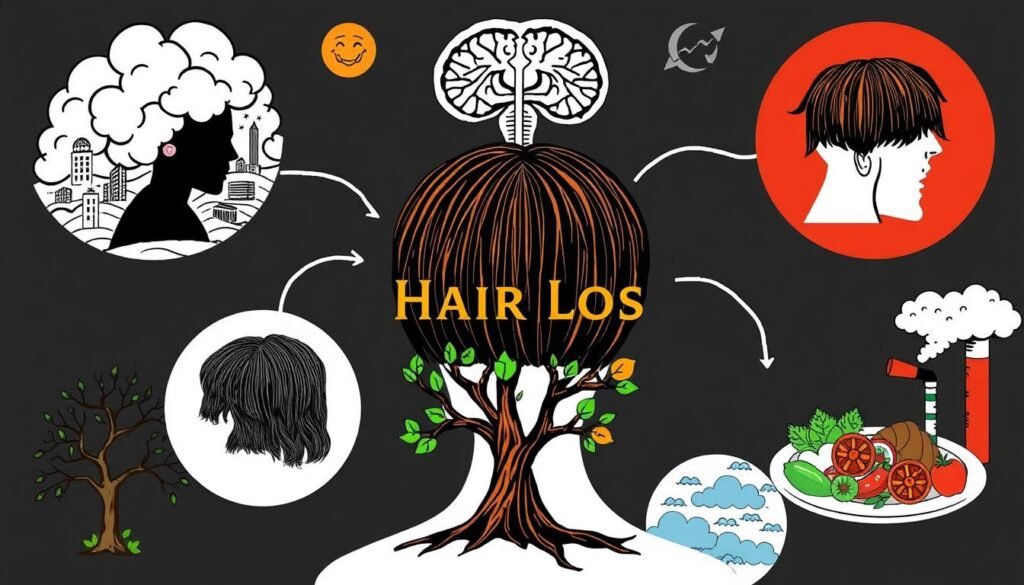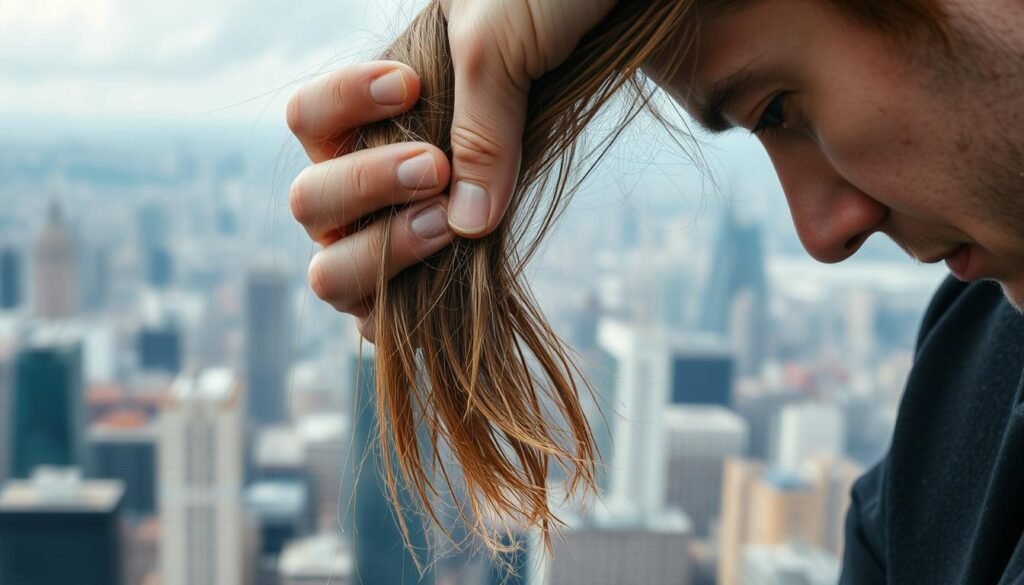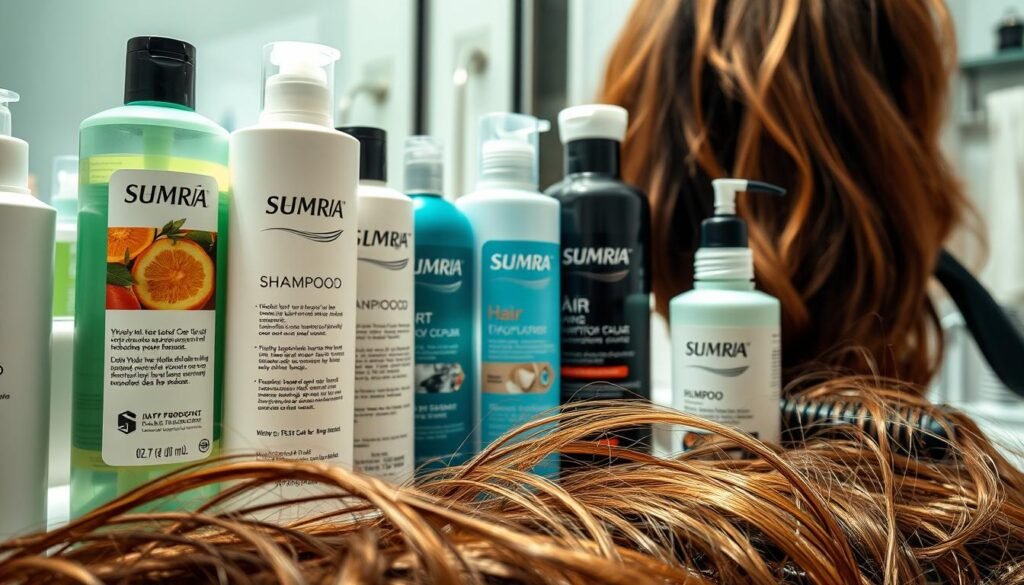Did you know over 85 percent of men experience balding by age 50? More than half of women also face hair loss in their lives. It’s vital to understand alopecia, or hair loss, especially if you’re worried about thinning hair or baldness. Hair loss can be either a temporary issue or a permanent condition. It’s often caused by genetics, hormonal shifts, or health problems.
Most baldness is due to hereditary factors and affects people differently. This is why it’s key to see a healthcare provider for advice suited to your condition. While we can’t prevent all forms of baldness, there are effective ways to keep our hair healthy and minimize hair loss.
Key Takeaways
- Hair loss can be temporary or permanent and affects both the scalp and entire body.
- Hereditary factors are the most common cause of baldness, with men more frequently affected.
- People typically lose 50 to 100 hairs per day; understanding this can alleviate concerns.
- Consulting healthcare providers can help identify personalized solutions to hair loss.
- Taking preventive measures can help manage hair health and reduce thinning hair.
Understanding Hair Loss and Baldness
Many people notice hair loss during their lives, which makes them worry about becoming bald. To really understand hair loss, know it can happen on the scalp or the whole body. Hair loss comes from genes, hormonal shifts, and getting older. These elements affect how hair falls out. Sometimes, they can cause lasting baldness.
The hair has three growth stages: anagen, catagen, and telogen. In the anagen phase, hair grows for 2 to 8 years. At this stage, about 90% of scalp hair is growing. Then, the catagen phase lasts 2 to 3 weeks. Hair prepares to rest. Lastly, the telogen phase takes 2 to 3 months. After this, hair sheds and the growth cycle starts over.
People often ask why baldness happens. Male-pattern baldness, mainly inherited, starts at the front or crown of the head. In women, baldness usually means thinning hair, but the hairline stays the same. Few women lose all their hair. Conditions like alopecia areata cause sudden hair loss in areas. But, many see their hair grow back in a few years. Scarring alopecias permanently stop hair from coming back. This shows why knowing about different hair loss types is key for finding treatments.
To fully understand hair loss, knowing the hair growth cycle is important. This cycle helps figure out why hair loss happens. It guides what steps to take next for those dealing with hair loss issues.
Common Causes of Hair Loss
Knowing why hair loss happens can help us fight it better. There are many reasons, from genes to health issues. Each cause affects people differently.
Genetic Factors and Androgenetic Alopecia
Genes play a big role in hair loss. Androgenetic alopecia, or pattern baldness, is common in both men and women. It can start in the teen years.
Men might see a receding hairline and thinning on top. Women often find their hair gets thinner all over. About 85% of men face this issue in their lives.
Hormonal Changes and Their Impact on Hair
Hormonal changes can lead to hair loss too. This can happen during pregnancy, menopause, or with thyroid problems. PCOS can also cause hair loss in women.
Childbirth and other stresses can make this worse. This sometimes leads to losing hair temporarily or for good.
Medical Conditions Leading to Baldness
Certain health issues can also lead to hair loss. Alopecia areata makes hair fall out in patches. It can grow back, but it’s tough to deal with.
Infections and illnesses like scalp psoriasis or diabetes can slow down hair growth. Treating these conditions can reduce hair loss.

| Cause of Hair Loss | Description | Impact on Individuals |
|---|---|---|
| Genetic Factors | Inheritance of hair loss traits from family | Prevalent in both men and women, often leading to permanent hair loss |
| Hormonal Changes | Changes due to pregnancy, menopause, thyroid issues, etc. | Can trigger temporary or permanent hair loss depending on the individual |
| Medical Conditions | Conditions such as alopecia areata, infections, and chronic diseases | May cause patchy loss or overall thinning, depending on the severity |
Types of Hair Loss: Recognizing Patterns
Knowing about different hair loss patterns helps in recognizing signs and getting the right help. Each type has its own traits that let people identify their specific situation. We will look at male and female pattern baldness, and alopecia areata. You’ll learn about their commonness and effects.
Male Pattern Baldness
Male pattern baldness is also called androgenetic alopecia. It impacts roughly two-thirds of males. It starts with a receding hairline and thinning hair on top of the head. It tends to get worse as one ages. More white people experience it compared to Afro-Caribbean folks. People of Chinese or Japanese descent rarely exhibit this condition. Having a family member with hair loss, especially on your mom’s side, raises your chances. The Folliscope® offers a close look at scalp conditions by magnifying up to 100 times, helping to understand hair loss better.
Female Pattern Baldness
Female pattern baldness shows up mostly as thinning hair on top of the head. It differs from how men experience hair loss. Hormonal imbalances, like too much androgen, are often to blame. Women’s hair thinning does not always lead to total baldness. But it can greatly affect one’s confidence and self-view. It is important for women to recognize these signs early for better management.
Patchy Hair Loss: Alopecia Areata
Alopecia areata means sudden, patchy hair loss in different areas, hitting men and women alike. This condition can be quite upsetting because hair falls out in small patches unexpectedly. While its exact cause is still a mystery, both genes and environment might play a role. Identifying alopecia areata early is key in setting realistic expectations and finding treatments.
Stress and Hair Loss
Stress plays a big role in losing hair. This includes both your emotions and physical health. Knowing how these stress types affect hair growth is key. It helps in dealing with hair loss better.
How Emotional Stress Affects Hair Growth
Emotional ups and downs can lead to hair loss. Conditions like telogen effluvium are common. Stress can cause a lot of your hair to fall out. You might start seeing more hair loss a few months after a stressful event. It’s normal to lose about 100 strands a day. But stress can increase this to 300.
This can last for months. It affects not just your hair but how you feel inside. It might make you feel worried or sad.
Physical Stressors and Their Impact
Things like surgery or getting really sick can also cause your hair to fall out. This is similar to emotional stress. It causes a condition where you lose a lot of hair. This usually gets better within six months. But it can last longer for some people.
Women, especially those aged 30 to 60, may notice it more. It usually happens on the top of the head. Complete baldness is rare, though. By understanding this, people can find ways to reduce stress. This helps hair grow back. For more on how stress affects hair, read this NIH article.

| Type of Stress | Impact on Hair Growth | Resolution Time |
|---|---|---|
| Emotional Stress | Increased shedding (telogen effluvium) | 3-6 months for acute cases |
| Physical Stress | Increased shedding (telogen effluvium) | Up to 6 months; can be chronic |
Knowing what causes stress can help a lot. It lets you find ways to handle it better. This is good for both your mood and your hair.
Hair Care Practices Contributing to Thinning Hair
Understanding the bad effects of some hair care routines is crucial for healthy hair. Styles and chemical treatments can speed up hair thinning. Knowing these risks helps with growth and lowers hair loss.
Hairstyles That Cause Traction Alopecia
Tight hairstyles like braids, ponytails, or buns can lead to traction alopecia. This happens when there’s constant pulling on hair roots. It can cause permanent loss if not addressed early. Changing hairstyles often and giving your scalp a break prevent this damage. Making smart hair care choices is essential for scalp health.
Dangers of Chemical Treatments
Chemical treatments, such as dyes and perms, are risky for hair. They can make hair weak and cause it to break. Using too many strong hair products can also lead to thinner hair. It’s better to use milder options and test new products on a small skin area first. To understand more about hair care and loss, check out this detailed article.

| Practice | Risk | Prevention |
|---|---|---|
| Tight Hairstyles | Traction Alopecia | Alternate styles regularly |
| Chemical Treatments | Hair Breakage | Use gentler alternatives |
| Harsh Hair Products | Increased Shedding | Limit usage of extreme-hold products |
Choosing softer hair care methods and avoiding harmful treatments can greatly lower the risk of thinning hair. This supports a healthier scalp.
Nutrition’s Role in Hair Health
Understanding how nutrition affects hair health is key for stopping hair thinning and loss. The right mix of vitamins and minerals is essential for hair growth and strength. Getting the right nutrition helps avoid the dietary shortages that often cause hair loss.
Essential Vitamins and Minerals for Hair Growth
Certain nutrients stand out for their hair benefits:
- Iron: Globally, a common deficiency is iron, which greatly affects hair growth.
- Vitamin D: Nearly 80% of people with hair loss have low vitamin D levels.
- Zinc: Lack of zinc is linked to common hair loss in men and women.
- Biotin: Known for aiding hair growth, low biotin can lead to loss.
- Protein: Crucial for hair structure, not enough protein can make hair thin.
Effects of Nutritional Deficiencies on Hair Loss
Many forget how lack of nutrition affects hair loss. Not getting enough hair vitamins can cause visible issues. For instance:
- Significant weight loss, like after bariatric surgery, may make hair fall out due to stress or nutrients lacking.
- Taking too much of supplements such as selenium and vitamin A can actually cause hair to fall out.
- People with hair loss often have low zinc, highlighting the need for a well-rounded diet.
For detailed info on how eating habits influence hair health and advice on eating better to improve hair growth, visit this resource.
Medical Treatments for Hair Loss
Dealing with hair loss can feel tough, but there are medical treatments that can help. Minoxidil and finasteride are two popular treatments that many people use. They have proven to work well in growing hair back and stopping hair loss.
Minoxidil and its Effectiveness
Minoxidil is also known as Rogaine. It’s a topical medication approved by the FDA to treat pattern baldness. It’s simple to use and works well for both men and women. Minoxidil effectiveness takes time, usually at least six months, to show results. During this time, users should keep an eye on their hair’s progress. Many see their hair loss stop and new hair grow, which is why minoxidil is a favorite choice.
Finasteride and Other Prescription Options
Finasteride is sold under the name Propecia. It’s mainly for men and helps by blocking a hair loss-causing hormone. Though effective, users should know about its potential side effects like less sex drive and a tiny chance of prostate cancer. For sudden hair loss, corticosteroids can be helpful. They slow down loss and help with hair regrowth. It’s essential to talk to a doctor to find the right treatment based on individual needs.
| Treatment | Type | Approval | Effectiveness Timeline |
|---|---|---|---|
| Minoxidil (Rogaine) | Topical | FDA-approved | 6+ months |
| Finasteride (Propecia) | Prescription | FDA-approved | 3-6 months |
| Corticosteroids | Prescription | FDA-approved | Varies |
Alternative and Natural Remedies
Many people look for other ways to handle hair loss, beyond usual treatments. Natural remedies are popular because they can be safer and have fewer side effects. These include herbal methods and practices that help hair grow and keep the scalp healthy.
Herbal Treatments
Several herbal treatments can help with hair health. For example, rosemary oil can work as well as minoxidil to help hair grow. Peppermint oil might boost blood flow to the scalp, which can lead to new hair growth. Experts also look at red ginseng for making hair thicker.
Onion juice, with its sulfur, can make hair strong and moisturize the scalp. Coconut oil and pumpkin seed oil are great for keeping the scalp hydrated and stopping DHT. This hormone is linked to male pattern baldness. A good discussion on these treatments can be found at Cleveland Clinic.
Scalp Massages and Their Benefits
Scalp massages are a simple way to help hair grow. They boost blood circulation in the scalp. This might make hair follicles healthier.
Research shows regular scalp massages could make hair thicker. Besides helping hair growth, massages can relax you. This adds to overall happiness. For those with hair loss, adding scalp massages to their routine can be helpful.
| Herbal Treatment | Benefits |
|---|---|
| Rosemary Oil | Promotes hair growth similar to minoxidil. |
| Peppermint Oil | Increases blood flow to the scalp. |
| Red Ginseng | Improves hair follicle activity. |
| Onion Juice | Strengthens hair and hydrates the scalp. |
| Coconut Oil | Hydrates scalp and strengthens hair follicles. |
| Pumpkin Seed Oil | Inhibits DHT to combat male pattern baldness. |
Preventive Measures to Avoid Going Bald
It’s crucial to take early action to prevent hair loss. Using a wide-toothed comb instead of brushes helps to lessen breakage. Also, staying away from tight hairstyles prevents hair from being pulled too hard. Regularly cutting hair ends and picking sulfate-free shampoos keeps the scalp healthy. This helps maintain hair strength over time.
Gentle Hair Care Practices
Leading a healthy lifestyle is key to boosting hair growth. Eating foods full of vitamins A, B, C, D, and E, along with zinc and iron, is good for your hair. These nutrients help avoid hair loss caused by not getting enough of these vitamins. Also, being active improves blood flow, helping nutrients reach hair follicles better. Using techniques to reduce stress, like meditation or yoga, benefits both your mind and hair.
Healthy Lifestyle Choices to Promote Hair Growth
Taking these steps for preventing hair loss builds confidence and offers a useful plan to keep hair healthy. By caring for hair gently and living healthily, fighting hair loss becomes much easier. This approach leads to having thicker and fuller hair.